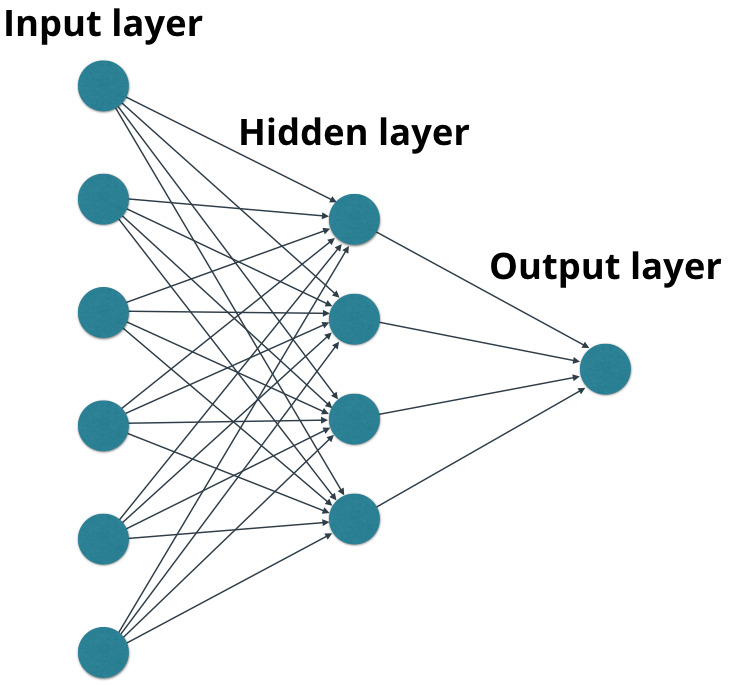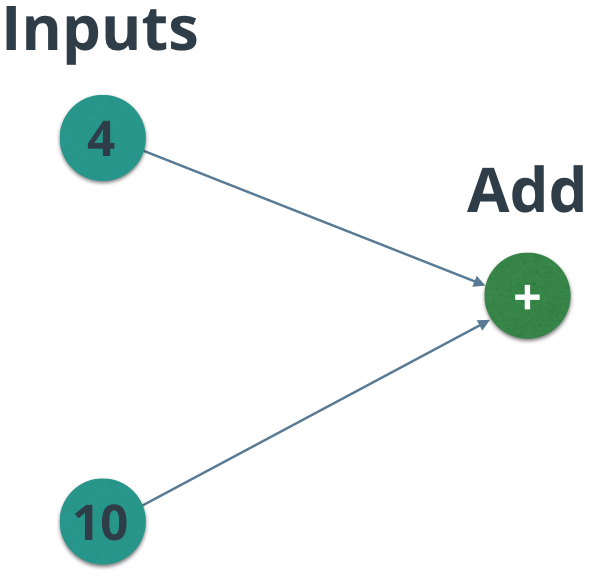22_动手实现TensorFlow–MiniFlow的架构
本文通过Python代码实现一个仿TensorFlow的神经网络框架——MiniFlow,该框架具备TensorFlow的核心特征,反向传播和计算图。
在实现MiniFlow之前我们先看一下计算图的含义。
什么是神经网络
神经网络是数学函数的图,例如由线性组合和激活函数,该图由节点和边组成。

每一层的节点(输入层节点除外)使用一个数学函数表示,将上一层的输出进行运算。例如一个节点可以用f(x,y)=x+y表示,x和y分别是上一层节点的输出。
同样的,每一个节点设置一个输出值,可以传递到下一层。在输入层和输出层之间的层都称为隐藏层。(Hidden Layer)
前向传播Forward Propagation
把输入值从输入层通过整个网络传播,穿过所有节点的数学函数,最终输出一个值,这个过程就叫前向传播
图
节点和边沿创建了一个图结构。通过前面的章节我们可以理解,图的结构越复杂,可以解决的问题越复杂。
创建神经网络一般有两个步骤:
1. 定义一个图,含节点(nodes)和边沿(edges)
2. 将数值通过图进行传播
我们的MiniFlow也是同样的实现方式。
MiniFlow的架构
我们使用一个Python 类(class)来表示节点(nodes)
class Node(object):
def __init__(self):
# Properties will go here!
我们知道每个节点可能从其他多个节点接收数据,同时每个节点只有一个输出,传递到其他节点。所以我们需要这个节点有两个列表:
1. inbound 用于存储输入关系
2. outbound用于存储输出关系
class Node(object):
def __init__(self, inbound_nodes=[]):
# Node(s) from which this Node receives values
self.inbound_nodes = inbound_nodes
# Node(s) to which this Node passes values
self.outbound_nodes = []
# For each inbound Node here, add this Node as an outbound Node to _that_ Node.
for n in self.inbound_nodes:
n.outbound_nodes.append(self)
每个节点最终都需要计算它的输出值,但初始化的时候首先将创建一个空的参数,初始化为None。
class Node(object):
def __init__(self, inbound_nodes=[]):
# Node(s) from which this Node receives values
self.inbound_nodes = inbound_nodes
# Node(s) to which this Node passes values
self.outbound_nodes = []
# For each inbound Node here, add this Node as an outbound Node to _that_ Node.
for n in self.inbound_nodes:
n.outbound_nodes.append(self)
# A calculated value
self.value = None
每一个节点需要能给进行前向和反向传播,现在我们先定义一个前向传播的函数,后续我们再处理反向传播
class Node(object):
def __init__(self, inbound_nodes=[]):
# Node(s) from which this Node receives values
self.inbound_nodes = inbound_nodes
# Node(s) to which this Node passes values
self.outbound_nodes = []
# For each inbound Node here, add this Node as an outbound Node to _that_ Node.
for n in self.inbound_nodes:
n.outbound_nodes.append(self)
# A calculated value
self.value = None
def forward(self):
"""
Forward propagation.
Compute the output value based on `inbound_nodes` and
store the result in self.value.
"""
raise NotImplemented
节点的计算
Node类定了一些基础的每一个节点都具备的特征。图结束的节点(输出层节点)有一些特殊的特征需要用子类来描述。下面我们实现一个Node类的输入子类
class Input(Node):
def __init__(self):
# An Input node has no inbound nodes,
# so no need to pass anything to the Node instantiator.
Node.__init__(self)
# NOTE: Input node is the only node where the value
# may be passed as an argument to forward().
#
# All other node implementations should get the value
# of the previous node from self.inbound_nodes
#
# Example:
# val0 = self.inbound_nodes[0].value
def forward(self, value=None):
# Overwrite the value if one is passed in.
if value is not None:
self.value = value
与其他Node的子类不同,这个input子类事实上没有做任何计算,这个子类仅仅用于保存数据。你可以通过forward()方法显式设置这个值。这个值可以输入到神经网络的其余节点。
加法子类(ADD)
add类是Node类的另一个子类,可以实现累加。

class Add(Node):
def __init__(self, x, y):
# You could access `x` and `y` in forward with
# self.inbound_nodes[0] (`x`) and self.inbound_nodes[1] (`y`)
Node.__init__(self, [x, y])
def forward(self):
"""
Set the value of this node (`self.value`) to the sum of it's inbound_nodes.
Your code here!
"""
self.value = self.inbound_nodes[0].value + self.inbound_nodes[1].value
总结
本文实现了神经网络MiniFlow的基础架构:
1. 通用节点类node class,包含输入、输出、值、前向传播函数
2. 输入节点类input class,为node的子类,只保存数据,不做计算
3. 加法节点类add class,为node的子类,做累加计算

发表评论
Want to join the discussion?Feel free to contribute!